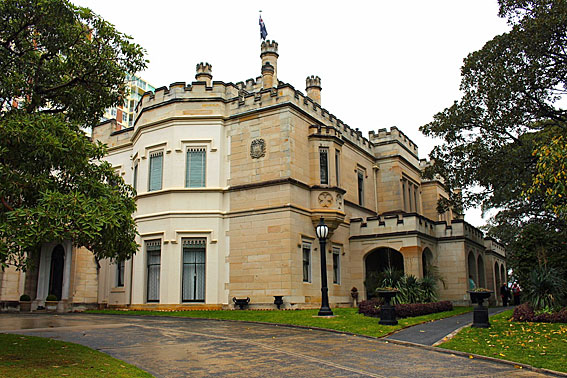
'Swifts', Darling Point, exterior
[photograph by Trevor Bunnning (4 October 2018)]

'Swifts', Darling Point, exterior
[photograph by Trevor Bunnning (4 October 2018)]
Historical and Technical Documentation by John Maidment
© OHTA, 2016 (last updated December 2016)
Construction of the first part of the mansion called 'Swifts', designed by G.A. Morell, took place between 1875 and 1877, commissioned by the eminent brewer Sir Robert Lucas-Tooth, the design based upon a family property in Kent. The building was enlarged in 1882 to the design of French-born Sydney architect Gustavus Alphonse Morrell. Built in sandstone in a Gothic style, it resembles Sydney's Government House, and includes a prominent tower, porte cochère and ballroom, in which the organ is placed. 'Swifts' later passed to the Resch family, also brewers, and then to the Catholic church. It was later acquired in the 1990s by the Moran family.1 Extensive restoration of the exterior and interior has taken place, the latter superbly redecorated in period style and refurnished to match what would have been placed in the rooms in the 19th century. Interestingly, painted roundels in the ballroom depicting noted composers were painted by Pamela Thalben-Ball, daughter of the distinguished Australian-born British organist Sir George Thalben-Ball.2
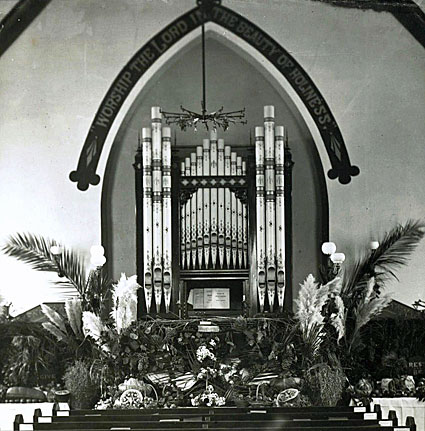
Congregational Church, Gawler, organ and church at harvest festival c.1900
[photograph kindly supplied by Dr Shane Moran]
The organ at the former Congregational Church, Gawler, South Australia was constructed by Fincham & Hobday, Adelaide, and opened at Gawler on 13 September 1885.3 It was enlarged to two-manuals in 1888 by the same firm by the addition of the Swell Organ to an existing single-manual organ, most of which was enclosed within a swell box, and moving of several ranks from the Great to the Swell. The drawstops were originally placed in a horizontal row beneath the music desk, but were rearranged (apart from the couplers) after the 1888 enlargement on the two narrow side jambs and a second keyboard inserted.
Following the closure of the church around 1976 the organ was moved into storage at a rural property at Williamstown, SA. In 2011 it was gifted to the Organ Historical Trust of Australia and in 2015 it was taken to the workshop of Hargraves Pipe Organs Pty Ltd, at Mt Evelyn, Vic. It was acquired by Dr Shane Moran for 'Swifts' in early 2016. It has been fully restored in 2016 by the Hargraves firm.
The restoration work included the case and console timbers, replacement of plywood ribs in the single-rise reservoir (dating from the 1960s) in solid timber and releathering of the folds, reconfiguration of the wooden trunking owing to a reduction in height of the building frame (the organ floor was lower than the console at Gawler), restoration of the manual and pedal roller boards and the two manual slider windchests, rebinding of the wooden trackers with new linen thread, refilling in red and black wax of the very fine drawstop label engraving and repainting of the building frame and swell box in matt black. The wooden pipework was in excellent condition overall; new stopper handles were made for the bass octave of the Pedal Bourdon. The keyboards were restored, using recycled ivory, and the pedal board recapped and repolished. The pipework retains its original cone tuning, pitch and voicing and required only minimal repair.
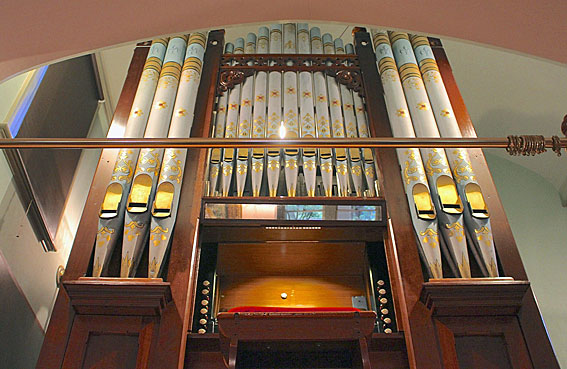
'Swifts', Darling Point: organ placed on loft in ballroom
[photograph by Trevor Bunnning (4 October 2018)]
| GREAT Open Diapason Claribel Dulciana Principal Fifteenth Swell to Great SWELL (1888) Open Diapason Gedact Gamba Flute Piccolo Oboe PEDAL Bourdon Great to Pedal Swell to Pedal |
8 8 8 4 2 8 8 8 4 2 8 16 |
bass in case CC-E (1885) stopped bass, open wood treble (1885) bass grooved to Claribel (1885) (1888) (2016 Hargraves Pipe Organs Pty Ltd) independent stopped bass (1888) (1888) bass grooved into Gedact (1888) stopped bass, open wood treble (1885) open wood, top octave metal (1885) Bassoon bass (1888) (1885) |
Compass: 56/30
Spotted metal pipework except zinc façade pipes
Mechanical key and stop action
Attached drawstop console
2 composition pedals to Great
Trigger swell lever
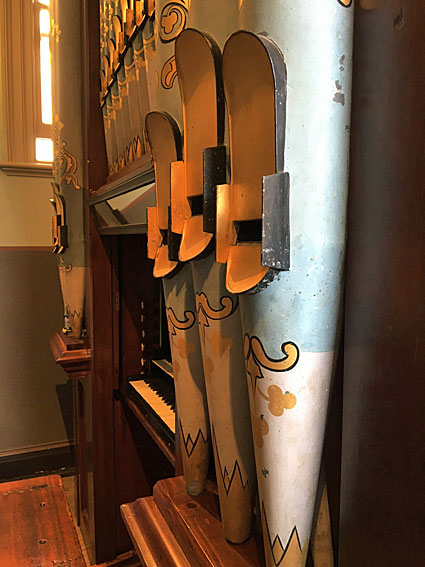
'Swifts', Darling Point: detail of façade pipes
[photograph by John Maidment (1 December 2016)]
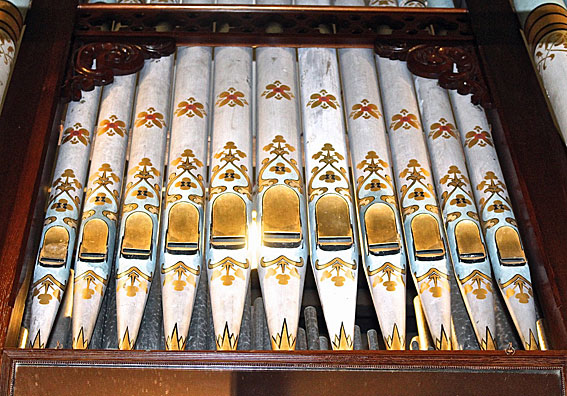
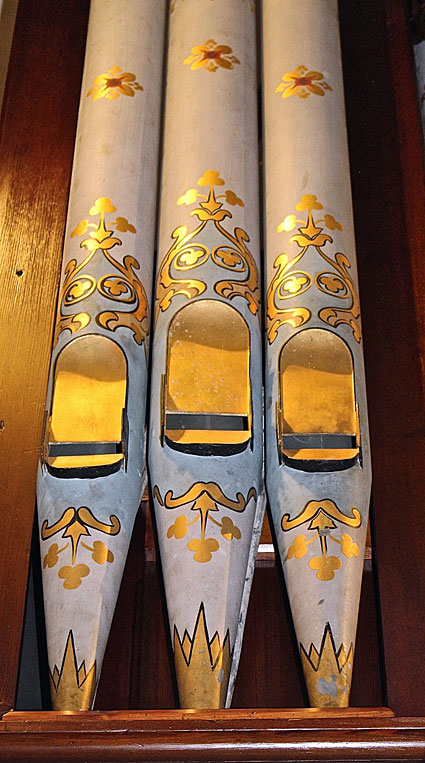
'Swifts', Darling Point: detail of façade pipes
[photographs by Trevor Bunnning (4 October 2018)]
The organ case has the pipes arranged 3 – 11 -3, with the longest basses at a lower level, on either side of the console. The façade pipes are attractively stencilled in gold (with black edging) on a light blue background, this work carried out by Heinrich Ludwig Vosz, of Adelaide, a leading decorator and stained glass artist in that city (born 1812 – died 1886). The casework is of pine, stained to resemble cedar and shellac polished. The stop jambs, key cheeks and key slips are ebonised.4
NEW ORGAN FOR GAWLER.
The Congregationalists of Gawler have adorned their beautiful church with a pipe organ erected by Messrs. Fincham & Hobday, of Adelaide. In these days when so much is said about encouragement to native industry it is pleasant to discover that there are in our midst enterprising individuals who are striving to localise manufactures in South Australia.
Messrs. Fincham & Hobday are working in this direction, and the instrument just opened is a testimony to their success, every part of it, even to the keys, having been manufactured in the colony. The organ is a small one suitable for the size of the church, and has been erected at a cost of £200. It has been voiced to suit the building, and has been regulated in the church. The whole of the material is of the best description and of the highest finish. As to the quality of the stops, though all are beautiful the dulcimer [Dulciana] is specially noteworthy for its sweetness of tone, and the pedal bourdon has been spoken of as almost equal to an open 16 feet pipe. A gentleman whose word in these matters is of the highest worth spoke highly of this organ for small churches. The pipes are composed of spotted metal, and the timber has been specially selected. The case is composed of pine, stained in imitation cedar, and the frontal pipes have been most beautifully illuminated in colors by Mr. Vosz, of Adelaide, harmonising admirably with the internal decorations of the church. The organ is composed of one manual of 56 notes, extending from CC to G, with seven stops ; the open diapason, metal for CC to G, 8 feet ; claribel, wood, CC to G, 8feet ; the dulcimer, metal, CC to G, 8 feet ; the wald flute, wood, 4 feet ; the piccolo, wood, 2 feet ; the pedal bourdon, CCC to F, 16 feet ; thirty notes, and the coupler manual to the pedals. There are two composition pedals for combination of the stops, and a crescendo pedal. The whole of the pipes except the diapason are enclosed in a swell box. To summarise, there are seven draw stops, 268 pipes in the manual, and thirty in the pedal organ.5
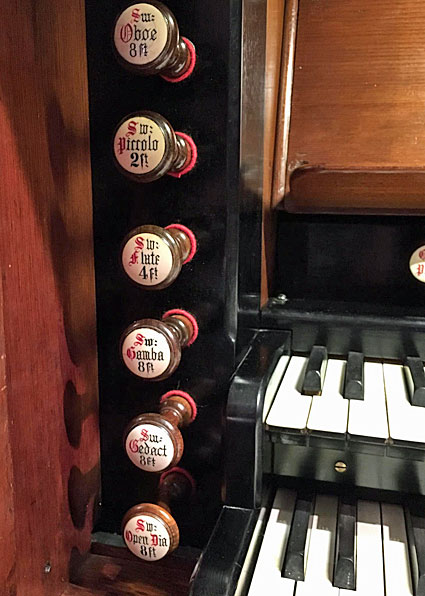
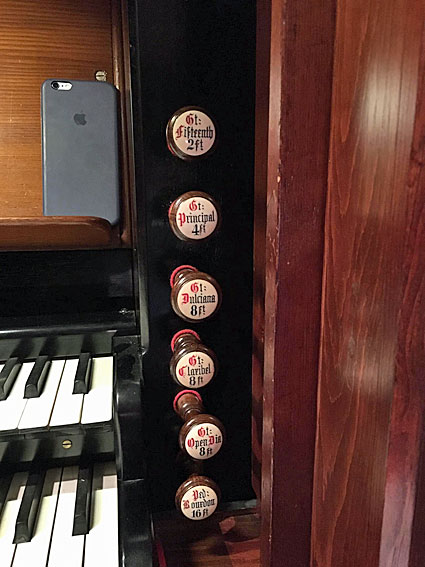
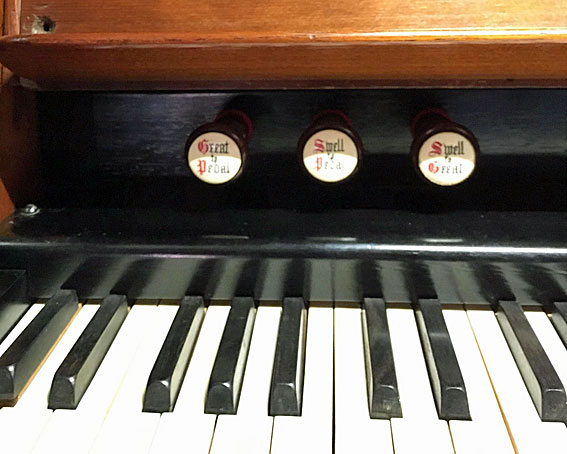
'Swifts', Darling Point: the restored console - details
[photographs by Alan Caradus (4 October 2018)]
The organ has been installed at 'Swifts' in an organ loft that originally housed a Welte orchestrion.6 The loft is around three metres above the floor of the ballroom, which is a resonant space offering an outstanding acoustic environment for the organ. The instrument differs considerably from the style of the organs built by the Melbourne branch of the firm, with a number of influences from the English firm of Hill & Son, evident in such things as the rounded ends to framing components, the adjustable backfall rail to the Swell and the small scale stopped wooden pipes with very high cut-ups. The rackboards employ turned wooden rack pillars (unlike the wooden strips used in Melbourne) and the pedal chests are divided at floor level, which rarely have happened in Melbourne. The Gamba pipes are fitted with horizontal metal bars between the ears. The voicing overall, is very bright and characterful, with pronounced articulation.
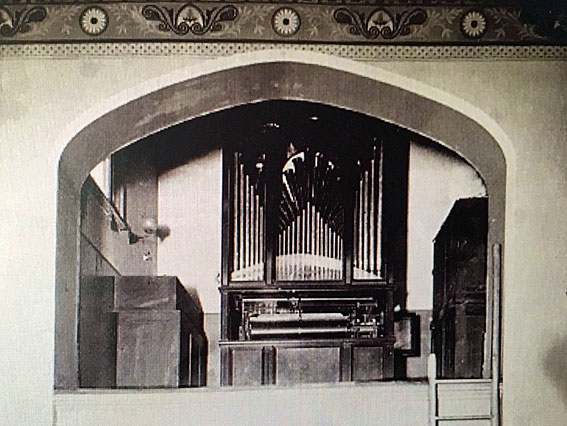
'Swifts', Darling Point: framed photograph in ballroom of the previous Welte orchestrion
[photograph by Alan Caradus (4 October 2018)]

'Swifts', Darling Point: organ placed on loft in ballroom
[photograph by Alan Caradus (4 October 2018)]
This is one of 11 new organs built by the firm in South Australia, together with a number of rebuildings, enlargements and restorations such as the instrument at Christ Church, Kapunda. Sadly only three of these survive unaltered (four if one counts the Kapunda instrument). The casework, façade pipe decoration, action and pipework all survive in a remarkably original state. It is thus a very rare survivor and one of the finest examples of 19th century Australian organbuilding to survive, now placed in an outstanding architectural, acoustical and historic environment.
1 https://en.wikipedia.org/wiki/Swifts,_Darling_Point accessed 4 December 2016
2 Observed by John Maidment from signatures on each painting
3 South Australian Weekly Chronicle, 19 September 1885, p.6
4 Details noted by John Maidment 2016
5 South Australian Weekly Chronicle, 19 September 1885
6 Graeme D. Rushworth, A Supplement to Historic Organs of New South Wales. Camberwell, Vic.: Organ Historical Trust of Australia, 2006, p.101

'Swifts', Darling Point: Great pipework
[photograph by John Maidment (1 December 2016)]
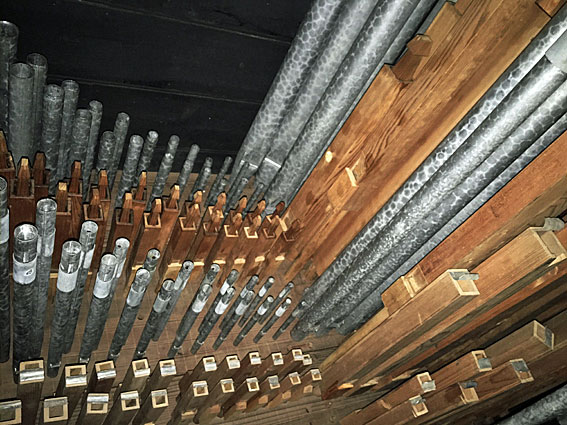
'Swifts', Darling Point: Swell pipework
[photograph by John Maidment (1 December 2016)]
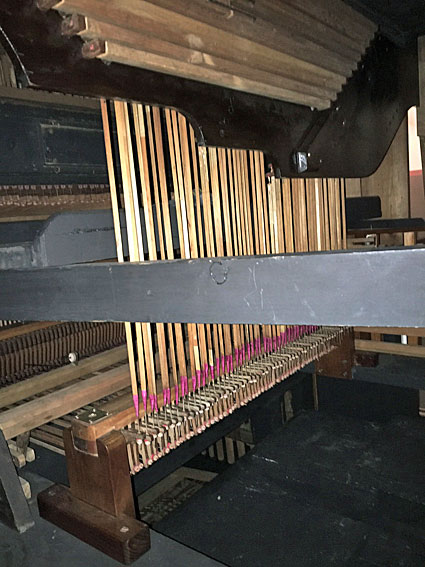
'Swifts', Darling Point: Swell action showing adjustable rail and trackers
[photograph by John Maidment (1 December 2016)]
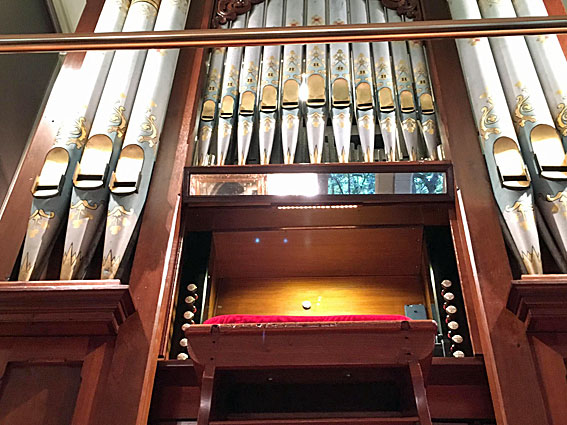

'Swifts', Darling Point: organ
[photographs by Alan Caradus (4 October 2018)]
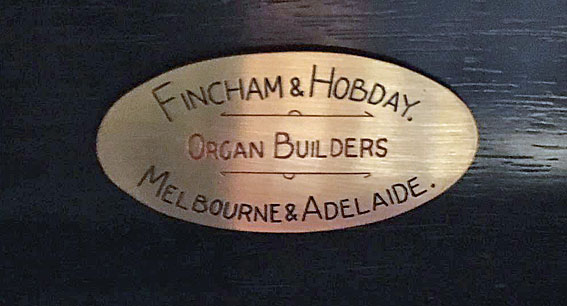
'Swifts', Darling Point: organbuilder nameplate
[photograph by Alan Caradus (4 October 2018)]
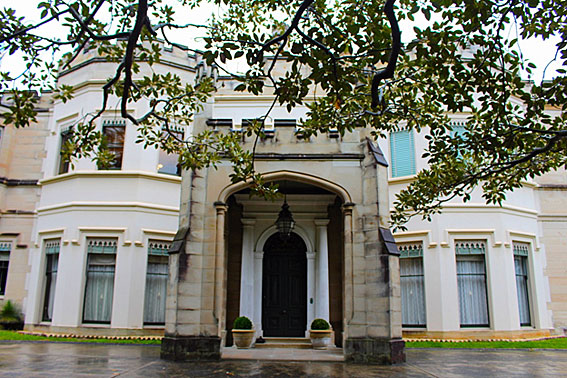
'Swifts', Darling Point, exterior
[photograph by Trevor Bunnning (4 October 2018)]
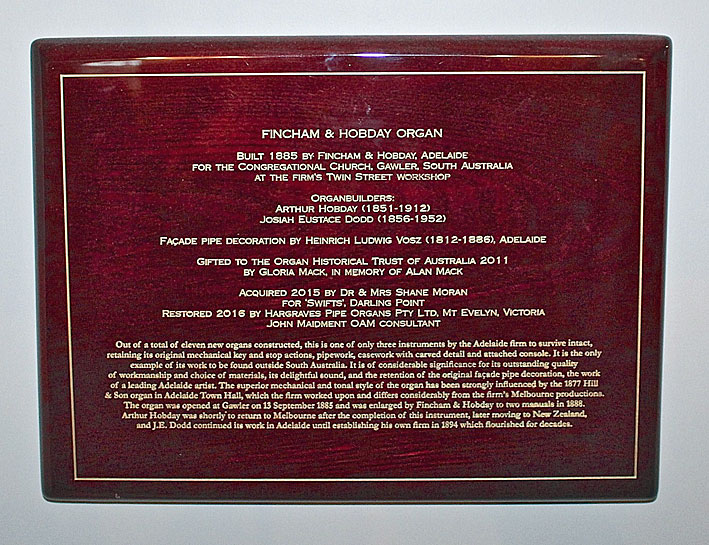
'Swifts', Darling Point: plaque in ballroom detailing history of the organ
[photograph by Trevor Bunnning (4 October 2018)]